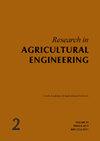柜式干燥机中辣木叶干燥参数的数学建模
Q3 Agricultural and Biological Sciences
引用次数: 0
摘要
本研究的重点是onÂ使用aÂ柜式干燥机干燥辣木叶。考虑了of 40、50和60 °C干燥空气温度onÂ含水率ofÂ叶片at aÂ恒定风速变化inÂ重量(40、80和120 g)的影响。拟合了10个干燥模型toÂ,干燥数据toÂ描述了干燥参数ofÂ辣木叶。根据onÂ最高系数ofÂ决定值(R2)和最低和ofÂ平方误差(SSE)和均方根误差(RMSE)值选择最佳模型。Henderson和Pabis模型最能描述辣木叶片的干燥特性ofÂ,其SSE最高R2 (0.9888), SSE最低(0.0401),RMSE最低(0.0604)。在8.72 Ă—10—9 to 1.40 Ă—10-8 m2·s-1范围内,有效水分扩散系数增大。40、80和120 g时的活化能分别为90.4636、40.4884和22.7466 KJ·mol-1。本文章由计算机程序翻译,如有差异,请以英文原文为准。
Mathematical modeling of drying parameters of moringa oleifera leaves in a cabinet drye
This study focused on drying moringa leaves using a cabinet dryer. The impact of the 40, 50, and 60 °C drying air temperatures on the moisture content of the leaves at a constant air velocity with variation in weight (40, 80, and 120 g) was considered. Ten drying models were fitted to the drying data to describe the drying parameters of moringa leaves. The best model was chosen based on the highest coefficient of determination (R2), and the lowest sum of square error (SSE) and root mean square error (RMSE) values. The Henderson and Pabis model best described the drying characteristics of the moringa leaves having the highest R2 (0.9888) and lowest SSE (0.0401) and RMSE (0.0604). The effective moisture diffusivity increased with the temperatures ranging from 8.72 Ă 10–9 to 1.40 Ă 10–8 m2·s–1. The activation energy ranged from 90.4636, 40.4884, and 22.7466 KJ·mol–1 for 40, 80, and 120 g, respectively.
求助全文
通过发布文献求助,成功后即可免费获取论文全文。
去求助
来源期刊

Research in Agricultural Engineering
Engineering, agriculture-
CiteScore
1.40
自引率
0.00%
发文量
21
审稿时长
24 weeks
期刊介绍:
Original scientific papers, short communications, information, and studies covering all areas of agricultural engineering, agricultural technology, processing of agricultural products, countryside buildings and related problems from ecology, energetics, economy, ergonomy and applied physics and chemistry. Papers are published in English.
 求助内容:
求助内容: 应助结果提醒方式:
应助结果提醒方式:


